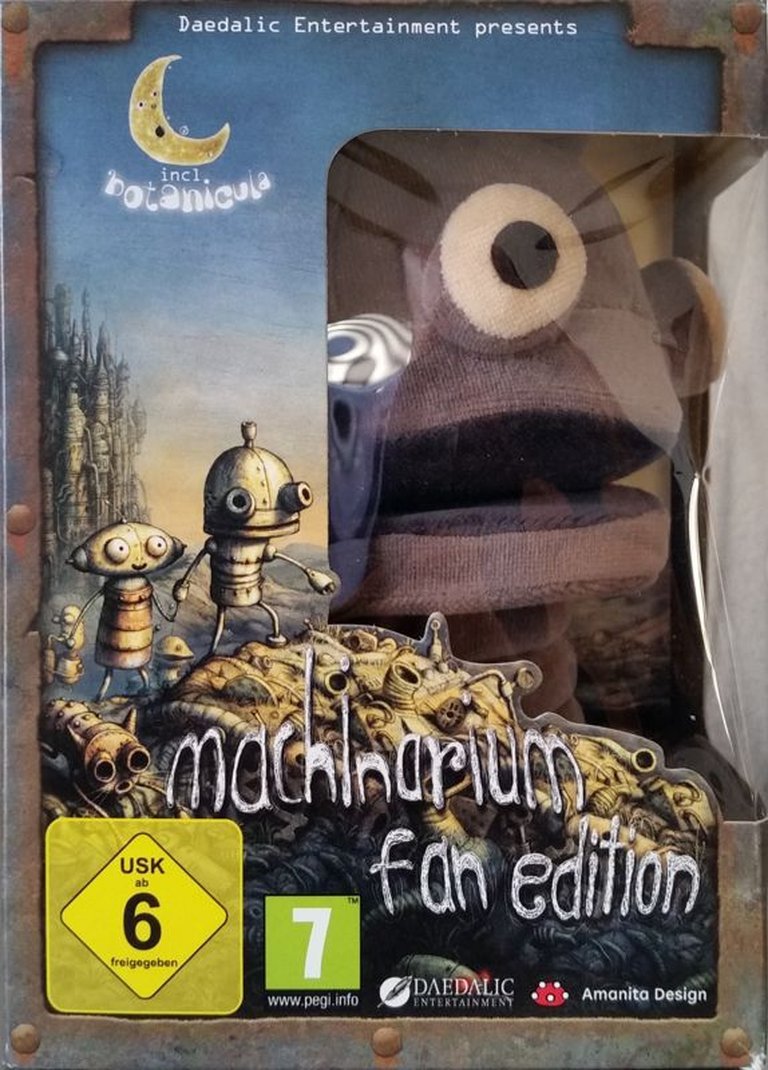- Release Year: 2012
- Platforms: Macintosh, Windows
- Publisher: Daedalic Entertainment GmbH
- Developer: Daedalic Entertainment GmbH
- Genre: Compilation, Special edition
- Game Mode: Single-player
- Average Score: 81/100

Description
Machinarium: Fan Edition is a special collector’s version of the acclaimed point-and-click adventure game, featuring a small robot named Josef on a mission to save his girlfriend Berta and defeat the Black Cap Brotherhood in a decaying, robot-inhabited city. The Fan Edition includes a cardboard box with a card game, posters, a plush figurine, and DVDs containing the games Machinarium, Samorost 2, and Botanicula, along with their original soundtracks.
Machinarium: Fan Edition Cracks & Fixes
Machinarium: Fan Edition Guides & Walkthroughs
Machinarium: Fan Edition Reviews & Reception
metacritic.com (85/100): A fantastic, rewarding, deeply satisfying adventure with one of the most beautiful game worlds you’ll see this side of a team Ico game; it’s a rare must-play.
opencritic.com (60/100): A robotic-themed adventure game composed of well-oiled and rusty parts.
metacritic.com (100/100): One of the most beautiful games to hit home computers in a long time.
Machinarium: Fan Edition: Review
Introduction
Machinarium: Fan Edition is a compilation of the critically acclaimed point-and-click puzzle adventure game Machinarium (2009), along with its prequel Samorost 2, wrapped in a premium physical package featuring a Pluche figurine, soundtracks, and an artistic card game. This review delves into the core gameplay experience of Machinarium, discussing how it maintains its status as a genre masterpiece while evaluating the added value of the Fan Edition components.
Development History & Context
Machinarium was developed by Czech studio Amanita Design over three years with a tiny team. Initially self-published via Steam and other digital platforms, it later came to consoles with PS3 and Vita versions. Due to restrictions with Xbox Live Arcade’s publishing requirements, Microsoft’s platform was initially skipped, which exemplifies the indie resilience characteristic of the era. The Fan Edition, released in 2012, adds physical bonuses without modifying the core game engine.
Narrative & Thematic Deep Dive
Set in a decaying steampunk city populated by robots, Machinarium follows the tale of Josef, a gentle robot dumped in the scrapyard who must rescue his girlfriend Berta from the malevolent Black Cap Brotherhood. The narrative unfolds through visual storytelling without dialogue, using thought bubbles filled with unique symbols and environmental elements to communicate Josef’s goals and memories.
The storytelling masterfully weaves together themes of love, corruption, and the struggle for self-improvement. Josef’s journey involves helping fellow citizens, defying bullies, and navigating elaborate mechanical contraptions. The absence of language creates a universal emotional resonance, allowing players of any nationality to connect with the narrative.
Gameplay Mechanics & Systems
Machinarium’s gameplay is centered around environmental puzzle-solving. Key mechanics include:
-
Point-and-Click with Reach Constraints: Only objects within Josef’s physical reach can be interpolated with, requiring players to manipulate the environment to extend Josef’s reach or move to new areas.
-
Contextual Item Usage: Items must be used in the correct context, often requiring a thorough exploration of each area to find the right place to apply them.
-
Two-Tier Hint System: A thought bubble hint that outlines the goal without revealing the solution, followed by a more direct walkthrough accessed via a Space Invaders-style minigame that provides step-by-step visual instructions.
-
Stock Puzzles with Unique Twists: Classic puzzle archetypes like block puzzles, pipe connections, and Hamiltonian path challenges are reimagined with creative, scenario-specific implementations that harmonize with the game’s sprawl.
The moves system is tight, with each successful interaction providing immediate feedback and the game flowing naturally between puzzles without jarring transitions. The difficulty curve starts off gentle then ramps up appropriately, ensuring a satisfying progression.
World-Building, Art & Sound
Visually, Machinarium stands out with its hand-drawn, watercolor-infused art direction. The city of Machinarium exudes a lived-in charm, filled with rusted machinery, decaying infrastructure, and eccentric mechanical characters. Each area, from the Governor’s Castle to the junkyard prison, is a treasure trove of environmental storytelling details.
The soundtrack by Floex masterfully combines industrial beats with emotive melodies, creating an aural landscape that complements the visual style. Sounds are used effectively to guide players, with ambient noises like steam hissing or robot servos whirring adding to the immersion.
Reception & Legacy
Upon release, Machinarium was a critical darling, garnering high scores from publications like Edge, Eurogamer, and IGN. It won awards such as the IGF Excellence in Visual Art and PC Gamer’s Best Soundtrack. Despite its indie status, it achieved commercial success with over 4 million sales, proving the viability of well-crafted single-player storytelling games in the market.
The game’s influence can be seen in subsequent adventure titles, setting a benchmark for art style, puzzle design, and non-verbal storytelling. The Fan Edition further cemented its status as a collector’s item, appealing to fans and casual players alike with its premium packaging and bonus materials.
Conclusion
Machinarium: Fan Edition isn’t just a game; it’s an experience that transcends the medium. With its enchanting world, engaging puzzles, and emotive narrative, it stands as a masterpiece of adventure game design. The physical components add value for collectors but it’s the core gameplay that truly shines. If you haven’t delved into this mechanical wonderland yet, do yourself a favor and experience the magic of Machinarium.